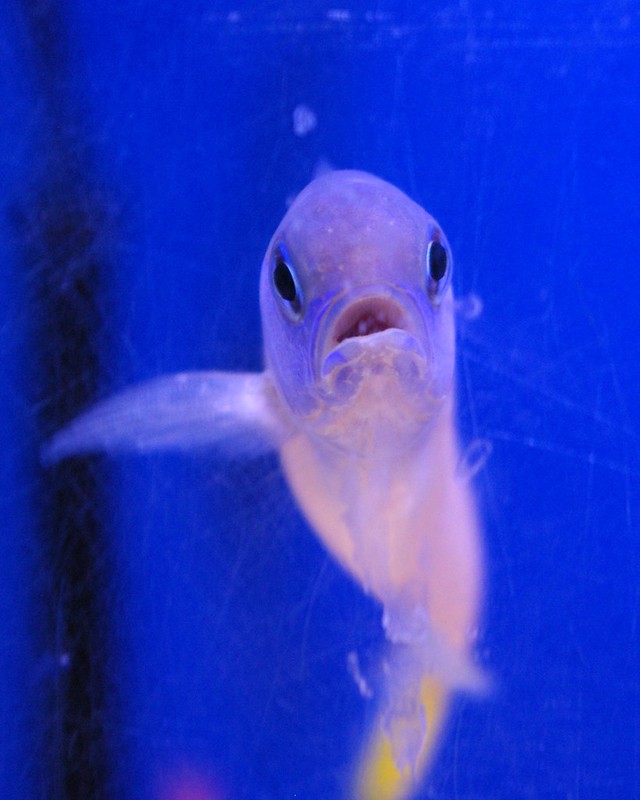Archive for the ‘Innovation’ Category
What do you like to do?
 I like to help people turn complex situations into several important learning objectives.
I like to help people turn complex situations into several important learning objectives.
I like to help people turn important learning objectives into tight project plans.
I like to help people distill project plans into a single-page spreadsheet of who does what and when.
I like to help people start with problem definition.
I like to help people stick with problem definition until the problems solve themselves.
I like to help people structure tight project plans based on resource constraints.
I like to help people create objective measures of success to monitor the projects as they go.
I like to help people believe they can do the almost impossible.
I like to help people stand three inches taller after they pull off the unimaginable.
I like to help people stop good projects so they can start amazing ones.
If you want to do more of what you like and less of what you don’t, stop a bad project to start a good one.
So, what do you like to do?
Image credit — merec0
Three Things for the New Year
 Next year will be different, but we don’t know how it will be different. All we know is that it will be different.
Next year will be different, but we don’t know how it will be different. All we know is that it will be different.
Some things will be the same and some will be different. The trouble is that we won’t know which is which until we do. We can speculate on how it will be different, but the Universe doesn’t care about our speculation. Sure, it can be helpful to think about how things may go, but as long as we hold on to the may-ness of our speculations. And we don’t know when we’ll know. We’ll know when we know, but no sooner. Even when the Operating Plan declares the hardest of hard dates, the Universe sets the learning schedule on its own terms, and it doesn’t care about our arbitrary timelines.
What to do?
Step 1. Try three new things. Choose things that are interesting and try them. Try to try them in parallel as they may interact and inform each other. Before you start, define what success looks like and what you’ll do if they’re successful and if they’re not. Defining the follow-on actions will help you keep the scope small. For things that work out, you’ll struggle to allocate resources for the next stages, so start small. And if things don’t work out, you’ll want to say that the projects consumed little resources and learned a lot. Keep things small. And if that doesn’t work, keep them smaller.
Step 2. Rinse and repeat.
I wish you a happy and safe New Year. And thanks for reading.
Mike
“three” by Travelways.com is licensed under CC BY 2.0
If you want to understand innovation, understand novelty.
 If you want to get innovation right, focus on novelty.
If you want to get innovation right, focus on novelty.
Novelty is the difference between how things are today and how they might be tomorrow. And that comparison calibrates tomorrow’s idea within the context of how things are today. And that makes all the difference. When you can define how something is novel, you have an objective measure of things.
How is it different than what you did last time? If you don’t know, either you don’t know what you did last time or you don’t know the grounding principle of your new idea. Usually, it’s a little of the former and a whole lot of the latter. And if you don’t know how it’s different, you can’t learn how potential customers will react to the novelty. In fact, if you don’t know how it’s different, you can’t even decide who are the right potential customers.
A new idea can be novel in unique ways to different customer segments and it can be novel in opposite ways to intermediaries or other partners in the business model. A customer can see the novelty as something that will make them more profitable and an intermediary can see that same novelty as something that will reduce their influence with the customer and lead to their irrelevance. And, they’ll both be right.
Novelty is in the eye of the beholder, so you better look at it from their perspective.
Like with hot sauce, novelty comes in a range of flavors and heat levels. Some novelty adds a gentle smokey flavor to your favorite meal and makes you smile while the ghost pepper variety singes your palate and causes you to lose interest in the very meal you grew up on. With novelty, there is no singular level of Scoville Heat Unit (SHU) that is best. You’ve got to match the heat with the situation. Is it time to improve things a bit with a smokey, yet subtle, chipotle? Or, is it time to submerge things in pure capsaicin and blow the roof off? The good news is the bad news – it’s your choice.
With novelty, you can choose subtle or spicy. Choose wisely.
And like with hot sauce, novelty doesn’t always mix well with everything else on the plate. At the picnic, when you load your plate with chicken wings, pork ribs, and apple pie, it’s best to keep the hot sauce away from the apple pie. Said more strongly, with novelty, it’s best to use separate plates. Separate the teams – one team to do heavy novelty work, the disruptive work, to obsolete the status quo, and a separate team to the lighter novelty work, the continuous improvement work, to enhance the existing offering.
Like with hot sauce, different people have different tolerance levels for novelty. For a given novelty level, one person can be excited while another can be scared. And both are right. There’s no sense in trying to change a person’s tolerance for novelty, they either like it or they don’t. Instead of trying to teach them to how to enjoy the hottest hot sauce, it’s far more effective to choose people for the project whose tolerance for novelty is in line with the level of novelty required by the project.
Some people like habanero hot sauce, and some don’t. And it’s the same with novelty.
If nine out of ten projects projects fail, you’re doing it wrong.
 For work that has not been done before, there’s no right answer. The only wrong answer is to say “no” to trying something new. Sure, it might not work. But, the only way to guarantee it won’t work is to say no to trying.
For work that has not been done before, there’s no right answer. The only wrong answer is to say “no” to trying something new. Sure, it might not work. But, the only way to guarantee it won’t work is to say no to trying.
If innovation projects fail nine out of ten times, you can increase the number of projects you try or you can get better at choosing the projects to say no to. I suggest you say learn to say yes to the one in ten projects that will be successful.
If you believe that nine out of ten innovation projects will fail, you shouldn’t do innovation for a living. Even if true, you can’t have a happy life going to work every day with a ninety percent chance of failure. That failure rate is simply not sustainable. In baseball, the very best hitters of all time were unsuccessful sixty percent of the time, yet, even they focused on the forty percent of the time they got it right. Innovation should be like that.
If you’ve failed on ninety percent of the projects you’ve worked on, you’ve probably been run out of town at least several times. No one can fail ninety percent of the time and hold onto their job.
If you’ve failed ninety percent of the time, you’re doing it wrong.
If you’ve failed ninety percent of the time, you’ve likely tried to solve the wrong problems. If so, it’s time to learn how to solve the right problems. The right problems have two important attributes: 1) People will pay you if they are solved. 2) They’re solvable. I think we know a lot about the first attribute and far too little about the second. The problem with solvability is that there’s no partial credit, meaning, if a problem is almost solvable, it’s not solvable. And here’s the troubling part: if a problem is almost solved, you get none of the money. I suggest you tattoo that one on your arm.
As a subject matter expert, you know what could work and what won’t. And if you don’t think you can tell the difference, you’re not a subject matter expert.
Here’s a rule to live by: Don’t work on projects that you know won’t work.
Here’s a corollary: If your boss asks you to work on something that won’t work, run.
If you don’t think it will work, you’re right, even if you’re not.
If it might work, that’s about right. If it will work, let someone else do it. If it won’t work, run.
If you’ve got no reason to believe it will work, it won’t.
If you can’t imagine it will work, it won’t.
If someone else says it won’t work, it might.
If someone else tries to convince you it won’t work, they may have selfish reasons to think that way.
It doesn’t matter if others think it won’t work. It matters what you think.
So, what do you think?
If you someone asks you to believe something you don’t, what will you do?
If you try to fake it until you make it, the Universe will make you pay.
If you think you can outsmart or outlast the Universe, you can’t.
If you have a bad feeling about a project, it’s a bad project.
If others tell you that it’s a bad project, it may be a good one.
Only you can decide if a project is worth doing.
It’s time for you to decide.
“Good example of Crossfit Weight lifting – In Crossfit Always lift until you reach the point of Failure or you tear something” by CrossfitPaleoDietFitnessClasses is licensed under CC BY 2.0
If you “don’t know,” you’re doing it right.
 If you know how to do it, it’s because you’ve done it before. You may feel comfortable with your knowledge, but you shouldn’t. You should feel deeply uncomfortable with your comfort. You’re not trying hard enough, and your learning rate is zero.
If you know how to do it, it’s because you’ve done it before. You may feel comfortable with your knowledge, but you shouldn’t. You should feel deeply uncomfortable with your comfort. You’re not trying hard enough, and your learning rate is zero.
Seek out “don’t know.”
If you don’t know how to do it, acknowledge you don’t know, and then go figure it out. Be afraid, but go figure it out. You’ll make mistakes, but without mistakes, there can be no learning.
No mistakes, no learning. That’s a rule.
If you’re getting pressure to do what you did last time because you’re good at it, well, you’re your own worst enemy. There may be good profits from a repeat performance, but there is no personal growth.
Why not find someone with “don’t know” mind and teach them?
Find someone worthy of your time and attention and teach them how. The company gets the profits, an important person gets a new skill, and you get the satisfaction of helping someone grow.
No learning, no growth. That’s a rule.
No teaching, no learning. That’s a rule, too.
If you know what to do, it’s because you have a static mindset. The world has changed, but you haven’t. You’re walking an old cowpath. It’s time to try something new.
Seek out “don’t know” mind.
If you don’t know what to do, it’s because you recognize that the old way won’t cut it. You know have a forcing function to follow. Follow your fear.
No fear, no growth. That’s a rule.
Embrace the “don’t know” mind. It will help you find and follow your fear. And don’t shun your fear because it’s a leading indicator of novelty, learning, and growth.
“O OUTRO LADO DO MEDO É A LIBERDADE (The Other Side of the Fear is the Freedom)” by jonycunha is licensed under CC BY-SA 2.0
Success Strangles
 Success demands people do what they did last time.
Success demands people do what they did last time.
Success blocks fun.
Success walls off all things new.
Success has a half-life that is shortened by doubling down.
Success eats novelty for breakfast.
Success wants to scale, even when it’s time to obsolete itself.
Success doesn’t get caught from behind, it gets disrupted from the bottom.
Success fuels the Innovator’s Dilemma.
Success has a short attention span.
Success scuttles things that could reinvent the industry.
Success frustrates those who know it’s impermanent.
Success breeds standard work.
Success creates fear around making mistakes.
Success loves a best practice, even after it has matured into bad practice.
Success doesn’t like people with new ideas.
Success strangles.
Success breeds success, right up until the wheels fall off.
Success is the antidote to success.
“20204-roots strangle bricks” by oliver.dodd is licensed under CC BY 2.0
Certainty or novelty – it’s your choice.
 When you follow the best practice, by definition your work is not new. New work is never done the same way twice. That’s why it’s called new.
When you follow the best practice, by definition your work is not new. New work is never done the same way twice. That’s why it’s called new.
Best practices are for old work. Usually, it’s work that was successful last time. But just as you can never step into the same stream twice, when you repeat a successful recipe it’s not the same recipe. Almost everything is different from last time. The economy is different, the competitors are different, the customers are in a different phase of their lives, the political climate is different, interest rates are different, laws are different, tariffs are different, the technology is different, and the people doing the work are different. Just because work was successful last time doesn’t mean that the old work done in a new context will be successful next time. The most important property of old work is the certainty that it will run out of gas.
When someone asks you to follow the best practice, they prioritize certainty over novelty. And because the context is different, that certainty is misplaced.
We have a funny relationship with certainty. At every turn, we try to increase certainty by doing what we did last time. But the only thing certain with that strategy is that it will run out of gas. Yet, frantically waving the flag of certainty, we continue to double down on what we did last time. When we demand certainty, we demand old work. As a company, you can have too much “certainty.”
When you flog the teams because they have too much uncertainty, you flog out all the novelty.
What if you start the design review with the question “What’s novel about this project?” And when the team says there’s nothing novel, what if you say “Well, go back to the drawing board and come back with some novelty.”? If you seek out novelty instead of squelching it, you’ll get more novelty. That’s a rule, though not limited to novelty.
A bias toward best practices is a bias toward old work. And the belief underpinning those biases is the belief that the Universe is static. And the one thing the Universe doesn’t like to be called is static. The Universe prides itself on its dynamic character and unpredictable nature. And the Universe isn’t above using karma to punish those who call it names.
“Stonecold certainty” by philwirks is licensed under CC BY-ND 2.0
Continuous Improvement Is Dead
 Continuous Improvement – Do what you did last time, just three percent better, so none of your people can try new things.
Continuous Improvement – Do what you did last time, just three percent better, so none of your people can try new things.
Discontinuous Improvement – Make a radical step-change in performance at the expense of continuously improving it.
Continuous Improvement – Do what you did last time so you can say “no” to projects that are magical.
No-To-Yes – Make the product do something it cannot. That way you can sell a new value proposition to new customers and new markets. And you can threaten those that are clinging to your tired value proposition.
Continuous Improvement – Do what you did last time so no one will be threatened by meaningful change.
Less With Far Less – Reduce the goodness of today’s offering to free up design space and create an entirely new offering that provides 80% of the goodness at 20% of the price. That way, you can sell a whole new family of offerings to customers that cannot buy today’s offering.
Continuous Improvement – Do what you did last time so we can rest on our laurels.
Obsolete Your Best Work – Design and commercialize new offerings that purposefully make obsolete your most profitable offering. This requires level 5 courage.
And how do you do all this? Mobilize the Trust Network.
“fear — may 9 (day 9)” by theogeo is licensed under CC BY 2.0
What should we do next?
 Anonymous: What do you think we should do next?
Anonymous: What do you think we should do next?
Me: It depends. How did you get here?
Anonymous: Well, we’ve had great success improving on what we did last time.
Me: Well, then you’ll likely do that again.
Anonymous: Do you think we’ll be successful this time?
Me: It depends. If the performance/goodness has been flat over your last offerings, then no. When performance has been constant over the last several offerings it means your technology is mature and it’s time for a new one. Has performance been flat over the years?
Anon: Yes, but we’ve been successful with our tried-and-true recipe and the idea of creating a new technology is risky.
Me: All things have a half-life, including successful business models and long-in-the-tooth technologies, and your success has blinded you to the fact that yours are on life support. Developing a new technology isn’t risky. What’s risk is grasping tightly to a business model that’s out of gas.
Anon: That’s harsh.
Me: I prefer “truthful.”
Anon: So, we should start from scratch and create something altogether new?
Me: Heavens no. That would be a disaster. Figure out which elements are blocking new functionality and reinvent those. Hint: look for the system elements that haven’t changed in a dog’s age and that are shared by all your competitors.
Anon: So, I only have to reinvent several elements?
Me: Yes, but probably fewer than several. Probably just one.
Anon: What if we don’t do that?
Me: Over the next five years, you’ll be successful. And then in year six, the wheels will fall off.
Anon: Are you sure?
Me: No, they could fall off sooner.
Anon: How do you know it will go down like that?
Me: I’ve studied systems and technologies for more than three decades and I’ve made a lot of mistakes. Have you heard of The Voice of Technology?
Anon: No.
Me: Well, take a bite of this – The Voice of Technology. Kevin Kelly has talked about this stuff at great length. Have you read him?
Anon: No.
Me: Here’s a beauty from Kevin – What Technology Wants. How about S-curves?
Anon: Nope.
Me: Here’s a little primer – Beyond Dead Reckoning. How about Technology Forecasting?
Anon: Hmm. I don’t think so.
Me: Here’s something from Victor Fey, my teacher. He worked with Altshuller, the creator of TRIZ – Guided Technology Evolution. I’ve used this method to predict several industry-changing technologies.
Anon: Yikes! There’s a lot here. I’m overwhelmed.
Me: That’s good! Overwhelmed is a sign you realize there’s a lot you don’t know. You could be ready to become a student of the game.
Anon: But where do I start?
Me: I’d start Wardley Maps for situation analysis and LEANSTACK to figure out if customers will pay for your new offering.
Anon: With those two I’m good to go?
Me: Hell no!
Anon: What do you mean?
Me: There’s a whole body of work to learn about. Then you’ve got to build the organization, create the right mindset, select the right projects, train on the right tools, and run the projects.
Anon: That sounds like a lot of work.
Me: Well, you can always do what you did last time. END.
“he went that way matey” by jim.gifford is licensed under CC BY-SA 2.0
The Dark Underbelly of Success
 Best practice – a tired recipe you recycle because you think the world is static.
Best practice – a tired recipe you recycle because you think the world is static.
Emergent practice – a new way to work created from whole cloth because the context is new.
Worst practice – a best practice applied to a world that has changed around you.
Novel practice– work that recognizes the world is a different place but is dismissed out-of-hand because everyone wants to live in the comfortable past.
Continuous improvement – when you try to put a shine on a tired, old process that worked ten years ago.
Discontinuous improvement – work that is disrespectful to the Status Quo and hurts people’s feelings.
Grow the core – when you do what you did in 2010 because you don’t know what else to do.
Obsolete your best work – when you do work that makes it clear to your customers that they should not have purchased your most successful product.
Reduce operating expense – what you do when you don’t know how to grow the top line and want to eliminate the flexibility to respond to an uncertain future.
Grow the top line – when you launch a new product that causes your customers to happily throw away the product they just bought from you.
A PowerPoint slide deck that defines your strategic plan – an electronic work product that distracts you from the reality of an ever-changing future.
A new product that is radically better than your last one – what you should create instead of a PowerPoint slide deck that defines your strategic plan.
MBA – a university degree that gives you a pedigree so companies hire you.
Ph.D. – a university degree that teaches you to learn, but takes too long.
Return On Investment (ROI) – a calculation that scuttles new work that would reinvent your business.
Imagination – thinking that will help you navigate an uncertain future, but is knee-capped by the ROI calculation.
Standard work – a process you used last time and will use next time because, again, you think the world is static.
Judgment – thinking that creates a whole new business trajectory to address an uncertain future but can get you fired if you use it.
A sustainable competitive advantage – a relic of a slow-moving world.
Continual change – the only way to deal with an ever-accelerating future.
Success – profits from work done by people who retired from your company some time ago.
Success – the thing that blocks you from working on the unproven.
Success – what pays the bills.
Success – what jeopardizes your ability to pay the bills in five years.
Success – why people think old practices are best practices.
Success – why new work is so difficult to do.
Success – why continuous improvement carries the day.
Success – why discontinuous improvement threatens.
Success – the mother of complacency.
“dark underbelly” by JoeBenjamin is licensed under CC BY-NC 2.0
The Innovation Mantra
 We have an immense distaste for uncertainty. And, as a result, we create for ourselves a radical and unskillful overestimation of our ability to control things. Our distaste of uncertainty is really a manifestation of our fear of death. When we experience and acknowledge uncertainty, it’s an oblique reminder that we will die. And that’s why talk ourselves into the belief we can control thing we really cannot. It’s a defense mechanism that creates distance between ourselves and from feeling our fear of death. And it’s the obliquity that makes it easier to overestimate our ability to control our environment. Without the obliquity, it’s clear we can’t control our environment, the very thing we wake up to every morning, and it’s clear we can’t control much. And if we can’t control much, we can’t control our aging and our ultimate end. And this is why we reject uncertainty at all costs.
We have an immense distaste for uncertainty. And, as a result, we create for ourselves a radical and unskillful overestimation of our ability to control things. Our distaste of uncertainty is really a manifestation of our fear of death. When we experience and acknowledge uncertainty, it’s an oblique reminder that we will die. And that’s why talk ourselves into the belief we can control thing we really cannot. It’s a defense mechanism that creates distance between ourselves and from feeling our fear of death. And it’s the obliquity that makes it easier to overestimate our ability to control our environment. Without the obliquity, it’s clear we can’t control our environment, the very thing we wake up to every morning, and it’s clear we can’t control much. And if we can’t control much, we can’t control our aging and our ultimate end. And this is why we reject uncertainty at all costs.
Predictable, controllable, repeatable, measurable – overt rejections of uncertainty. Six Sigma – Measure, Analyze, Improve, Control – overt rejection of uncertainty. Standard work – rejection of uncertainty. Don’t change the business model – a rejection of uncertainty. A rejection of novelty is a rejection of uncertainty. And that’s why we don’t like novelty. It scares us deeply. And it scares us because it reminds us that everything changes, including our skin, joints, and hairline. And that’s why it’s so challenging to do innovation.
Innovation reminds us of our death and that’s why it’s difficult? Really? Yes.
Six Sigma is comforting because its programmatic illusion of control lets us forget about our death? Yes.
The aging business model reminds us of our death and that’s why we won’t let it go? Yes.
That’s crazy! Yes, but at the deepest level, I think it’s true.
I understand if you disagree with my rationale. And I understand if you think my thinking is morbid. If that’s the case, I suggest you write down why you think it’s so incredibly difficult to create a new business model, to do novel work, or to obsolete your best work. I’ll stop for a minute to give you time to grab a pen and paper. Okay, now put your pen to paper and write down why doing innovation (doing novel work) is so difficult. Now, ask yourself why that is. And do that three more times. Where did you end up? What’s the fundamental reason why doing new work (and the uncertainty that comes with it) is so difficult to do?
To be clear, I’m not advocating that you tell everyone that innovation is difficult because it reminds them that they’ll die. I explained my rationale to give you an idea of the magnitude of the level of fear around uncertainty so that, when someone is scared to death of novelty, you might help them navigate their fear.
Trying something new doesn’t invalidate what you did over the last decade to grow your business, nor will it replace it immediately, if it all. Maybe the new work will add to what you’ve done over the last decade. Maybe the new work will amplify what’s made you successful. Maybe the new work will slowly and effectively migrate your business to greener pastures. And maybe it won’t work at all. Or, maybe your customers will make it work and bury you and your business.
With innovation, start small. That way the threat is smaller. Run small experiments and share the results, especially the bad results. That way you demonstrate that unanticipated results don’t kill you and, when you share them, you demonstrate that you’re not afraid of uncertainty. Try many things in parallel to demonstrate that it’s okay that everything doesn’t turn out well and you’re okay with it. And when someone asks what you’ll do next, tell them “I don’t know because it depends on how the next experiment turns out.”
When you’re asked when you’ll be done with an innovation project, tell them “I don’t know because the work has never been done before.” And if they say you must give them a completion date, tell them “If you must have a completion date, you do the project.”
When you’re running multiple experiments in parallel and you’re asked what you’ll do next, tell them you’ll do “more of what works and less of what doesn’t.” And if they say “that’s not acceptable”, then tell them “Well, then you run the project.”
We don’t have nearly as much control as our minds want to us believe, but that’s okay as long as we behave like we know it’s true. Uncertainty is uncomfortable, but that’s not a bad thing. In fact, I think it’s a good thing.
If people aren’t afraid, there can be no uncertainty. And if there’s no uncertainty, there can be no novelty. And if there’s no novelty, there can be no innovation. If people aren’t afraid, you’re doing it wrong.
As a leader, tell them you’re afraid but you’re going to do it anyway.
As a leader, tell your team that it’s natural to be afraid and their fear is a leading indicator of innovation.
As a leader, tell them there’s one thing you’re certain about – that innovation is uncertain.
And when things get difficult, repeat the Innovation Mantra: Be afraid and do it anyway.
“Mantra” by j / f / photos is licensed under CC BY-ND 2.0
 Mike Shipulski
Mike Shipulski